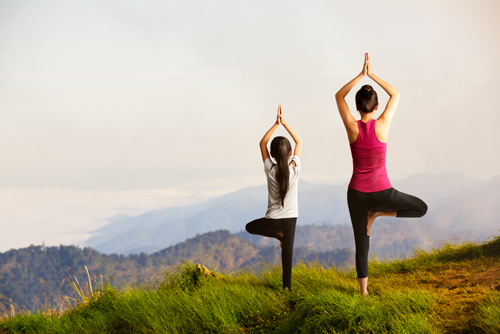Peeking in on children’s yoga classes, I watch kids doing poses such as tree, snake, butterfly, or lion, while the instructor tells a story about the various ways these creatures behave in nature. As the children wiggle and twist their bodies, I hear roaring and hissing, usually followed by bouts of giggling. Sometimes the children demonstrate poses or lead their class through a favorite pose. The kids also play games. The favorite is when different sized marbles are poured on the floor, and they have to pick them up with their feet and hop back to their mats, where a paper cup is placed to receive the marbles.
Yoga—and in particular, yogic breathing, or pranayama—can reduce the number of asthma attacks and the need for medication in chronic asthmatics. Yogic breathing techniques also have been shown to decrease children’s hyperactivity, inattention, and anxiety, while also improving peer relations.
Bringing the Wild Outdoors Inside
While researchers like Richard Louv, author of Last Child in the Woods: Saving Our Children from Nature-Deficit Disorder, point out that our children’s lives have become too structured and that many of these modern ills might best be alleviated with more free play outside, it is also true that the structure of yoga can provide freedom. Through yoga, children learn about influencing their own reality and health through intent, by breathing and focusing their minds, while becoming more attuned to the sensations of their bodies. The practice also helps them to learn to trust their own inner voice and guidance, rather than relying on something outside of themselves, such as their peers or the media.
Through yoga, children learn about influencing their own reality and health through intent, by breathing and focusing their minds, while becoming more attuned to the sensations of their bodies. The practice also helps them to learn to trust their own inner voice and guidance, rather than relying on something outside of themselves, such as their peers or the media.
Getting Kids to Breathe
Because much of the emphasis in yoga is placed on the breath, various techniques of pranayama are usually incorporated into the classes. Some examples may include three-part breathing, belly breathing, or the teacher’s reminder to continually “come back to the breath.” The overall result? A more relaxed body and a quieter, calmer mind.
An example of a common breathing exercise is for the teacher to have the children lie on their mats with their eyes closed. They are encouraged to inhale slowly for a count of five and exhale for a count of ten (inhale to exhale ratio being 1:2). This particular exercise, when practiced regularly, has been shown to reduce asthma attacks in chronic asthmatics. The exact mechanism is not known; nevertheless, learning yogic breathing is a fun and simple way for a child to control his or her symptoms. These effects are further enhanced by being in a room with warm, moist air.
Focusing on the breath and finding stillness is a huge accomplishment and a tool that can be used throughout life. You can remind your child that he can always “come back to his breath,” and only he has control of that.
Circle games are often included to give a greater feeling of community. One example: the children sit in a circle with their teacher while one person holds a ball or object. The person with the ball shares something with the group that makes her happy or something for which she feels grateful, and then she passes the ball to the next friend. This not only gives an opportunity for each child to be heard, but creates an overall feeling of shared well-being.
Your Shared Practice
If your child is involved in a yoga class in your area, and you want to learn more about it, ask to sit in and observe. You may be delighted at what you see. Experiencing yoga with your child is a simple way for you to help your child take what he or she is learning in class “off the mat.”
If you already have a practice or want to learn, try doing yoga together with your child. This can foster bonding, an understanding of the process your child is undertaking, touch, acceptance, cooperation, and a chance to face new challenges. If a child is able to get from an aroused state to a feeling of centeredness and well-being—whether through a handstand balance or just the simple act of closing one’s eyes, focusing on the breath, and finding stillness—it will be a huge accomplishment and a tool that can be used throughout life. You can remind your child that he can always “come back to his breath,” and only he has control of that.
“Helping Kids to Connect Body, Breath, and Mind” by Miriam Mandel was originally published on Spirituality & Health. To view the original article, click here.
Click here to see Rose’s tips for healthy and happy relationships



